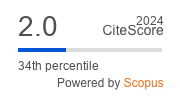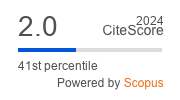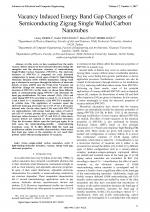| 3/2017 - 2 |
Vacancy Induced Energy Band Gap Changes of Semiconducting Zigzag Single Walled Carbon NanotubesDERELI, G. |
| Extra paper information in |
| Click to see author's profile in |
| Download PDF |
Author keywords
single-walled carbon nanotubes, order N tight-binding molecular dynamics, vacancy, energy band gap, electronic properties
References keywords
carbon(29), nanotubes(21), single(11), tight(10), binding(10), walled(8), properties(8), molecular(8), electronic(8), dynamics(7)
Blue keywords are present in both the references section and the paper title.
About this article
Date of Publication: 2017-08-31
Volume 17, Issue 3, Year 2017, On page(s): 11 - 18
ISSN: 1582-7445, e-ISSN: 1844-7600
Digital Object Identifier: 10.4316/AECE.2017.03002
Web of Science Accession Number: 000410369500002
SCOPUS ID: 85028550042
Abstract
In this work, we have examined how the multi-vacancy defects induced in the horizontal direction change the energetics and the electronic structure of semiconducting Single-Walled Carbon Nanotubes (SWCNTs). The electronic structure of SWCNTs is computed for each deformed configuration by means of real space, Order(N) Tight Binding Molecular Dynamic (O(N) TBMD) simulations. Energy band gap is obtained in real space through the behavior of electronic density of states (eDOS) near the Fermi level. Vacancies can effectively change the energetics and hence the electronic structure of SWCNTs. In this study, we choose three different kinds of semiconducting zigzag SWCNTs and determine the band gap modifications. We have selected (12,0), (13,0) and (14,0) zigzag SWCNTs according to n (mod 3) = 0, n (mod 3) = 1 and n (mod 3) = 2 classification. (12,0) SWCNT is metallic in its pristine state. The application of vacancies opens the electronic band gap and it goes up to 0.13 eV for a di-vacancy defected tube. On the other hand (13,0) and (14,0) SWCNTs are semiconductors with energy band gap values of 0.44 eV and 0.55 eV in their pristine state, respectively. Their energy band gap values decrease to 0.07 eV and 0.09 eV when mono-vacancy defects are induced in their horizontal directions. Then the di-vacancy defects open the band gap again. So in both cases, the semiconducting-metallic - semiconducting transitions occur. It is also shown that the band gap modification exhibits irreversible characteristics, which means that band gap values of the nanotubes do not reach their pristine values with increasing number of vacancies. |
| References | | | Cited By «-- Click to see who has cited this paper |
| [1] S. Iijima and T. Ichihashi, "Single-shell carbon nanotubes of 1-nm diameter," Nature, vol. 363, no. 6430, pp. 603-605, 1993. [CrossRef] [Web of Science Times Cited 7415] [SCOPUS Times Cited 8387] [2] P. Avouris, Z. Chen, and V. Perebeinos, "Carbon-based electronics," Nat Nano, vol. 2, no. 10, pp. 605-615, Oct. 2007. [CrossRef] [Web of Science Times Cited 2207] [SCOPUS Times Cited 2367] [3] C. Dekker, "Carbon Nanotubes as Molecular Quantum Wires," Phys. Today, vol. 52, no. 5, pp. 22-28, 1999. [CrossRef] [Web of Science Times Cited 1254] [SCOPUS Times Cited 1368] [4] T. W. Ebbesen and T. Takada, "Topological and SP3 defect structures in nanotubes," Carbon N. Y., vol. 33, no. 7, pp. 973-978, Jan. 1995. [CrossRef] [Web of Science Times Cited 240] [SCOPUS Times Cited 251] [5] A. Hashimoto, K. Suenaga, A. Gloter, K. Urita, and S. Iijima, "Direct evidence for atomic defects in graphene layers.," Nature, vol. 430, no. 7002, pp. 870-873, Aug. 2004. [CrossRef] [Web of Science Times Cited 1501] [SCOPUS Times Cited 1610] [6] J. A. Rodriguez-Manzo and F. Banhart, "Creation of individual vacancies in carbon nanotubes by using an electron beam of 1? Å diameter," Nano Lett., vol. 9, no. 6, pp. 2285-2289, 2009. [CrossRef] [Web of Science Times Cited 132] [SCOPUS Times Cited 142] [7] A. Tolvanen, G. Buchs, P. Ruffieux, P. Groning, O. Groning, and A. V Krasheninnikov, "Modifying the electronic structure of semiconducting single-walled carbon nanotubes by Ar+ ion irradiation," Phys. Rev. B, vol. 79, no. 12, p. 125430, Mar. 2009. [CrossRef] [Web of Science Times Cited 44] [SCOPUS Times Cited 51] [8] J. A. Robinson, E. S. Snow, S. C. Badescu, T. L. Reinecke, and F. K. Perkins, "Role of Defects in Single-Walled Carbon Nanotube Chemical Sensors," Nano Lett., vol. 6, no. 8, pp. 1747-1751, Aug. 2006. [CrossRef] [Web of Science Times Cited 410] [SCOPUS Times Cited 428] [9] M. K. Kostov, E. E. Santiso, A. M. George, K. E. Gubbins, M. B. Nardelli, "Dissociation of Water on Defective Carbon Substrates," Phys. Rev. Lett., vol. 95, no. 13, p. 136105, Sep. 2005. [CrossRef] [Web of Science Times Cited 133] [SCOPUS Times Cited 148] [10] L.-G. Tien, C.-H. Tsai, F.-Y. Li, M.-H. Lee, "Band-gap modification of defective carbon nanotubes under a transverse electric field," Phys. Rev. B, vol. 72, no. 24, p. 245417, Dec. 2005. [CrossRef] [Web of Science Times Cited 36] [SCOPUS Times Cited 36] [11] Y. V Shtogun, L. M. Woods, "Electronic and magnetic properties of deformed and defective single wall carbon nanotubes," Carbon N. Y., vol. 47, no. 14, pp. 3252-3262, Nov. 2009. [CrossRef] [Web of Science Times Cited 37] [SCOPUS Times Cited 39] [12] H. Zeng, J. Zhao, H. Hu, J.-P. Leburton, "Atomic vacancy defects in the electronic properties of semi-metallic carbon nanotubes," J. Appl. Phys., vol. 109, no. 8, 2011. [CrossRef] [Web of Science Times Cited 12] [SCOPUS Times Cited 14] [13] G. Kim, B. W. Jeong, J. Ihm, "Deep levels in the band gap of the carbon nanotube with vacancy-related defects," Appl. Phys. Lett., vol. 88, no. 19, 2006. [CrossRef] [Web of Science Times Cited 44] [SCOPUS Times Cited 46] [14] S.-H. Jhi, "An ab initio study of the electronic properties of carbon nanotubes activated by hydrogen-passivated vacancies," Carbon N. Y., vol. 45, no. 10, pp. 2031-2036, Sep. 2007. [CrossRef] [Web of Science Times Cited 4] [SCOPUS Times Cited 5] [15] L. V. Liu, W. Q. Tian, Y. A. Wang, "Ab initio studies of vacancy-defected fullerenes and single-walled carbon nanotubes," Int. J. Quantum Chem., vol. 109, no. 14, pp. 3441-3456, 2009. [CrossRef] [Web of Science Times Cited 20] [SCOPUS Times Cited 20] [16] Q.-X. Zhou, C.-Y. Wang, Z.-B. Fu, Y.-J. Tang, H. Zhang, "Effects of various defects on the electronic properties of single-walled carbon nanotubes: A first principle study," Front. Phys., vol. 9, no. 2, pp. 200-209, 2014. [CrossRef] [Web of Science Times Cited 31] [SCOPUS Times Cited 32] [17] J. Kotakoski, A. V Krasheninnikov, K. Nordlund, "Energetics, structure, and long-range interaction of vacancy-type defects in carbon nanotubes: Atomistic simulations," Phys. Rev. B, vol. 74, no. 24, p. 245420, 2006. [CrossRef] [Web of Science Times Cited 186] [SCOPUS Times Cited 198] [18] L.-G. Tien, C.-H. Tsai, F.-Y. Li, M.-H. Lee, "Influence of vacancy defect density on electrical properties of armchair single wall carbon nanotube," Diam. Relat. Mater., vol. 17, no. 4-5, pp. 563-566, Apr. 2008. [CrossRef] [Web of Science Times Cited 11] [SCOPUS Times Cited 10] [19] Y.-J. Kang, Y.-H. Kim, K. J. Chang, "Electrical transport properties of nanoscale devices based on carbon nanotubes," Curr. Appl. Phys., vol. 9, no. 1, Supplement, pp. S7-S11, Jan. 2009. [CrossRef] [Web of Science Times Cited 23] [SCOPUS Times Cited 24] [20] V. V Belavin, L. G. Bulusheva, A. V Okotrub, "Modifications to the electronic structure of carbon nanotubes with symmetric and random vacancies," Int. J. Quantum Chem., vol. 96, no. 3, pp. 239-246, 2004. [CrossRef] [Web of Science Times Cited 14] [SCOPUS Times Cited 15] [21] C. Ozdogan, G. Dereli, T. Çagin, "O(N) parallel tight binding molecular dynamics simulation of carbon nanotubes," Comput. Phys. Commun., vol. 148, no. 2, pp. 188-205, 2002. [CrossRef] [Web of Science Times Cited 13] [SCOPUS Times Cited 15] [22] G. Dereli, C. Ozdogan, "O(N) algorithms in tight-binding molecular-dynamics simulations of the electronic structure of carbon nanotubes," Phys. Rev. B, vol. 67, no. 3, p. 35415, 2003. [CrossRef] [Web of Science Times Cited 10] [SCOPUS Times Cited 1] [23] G. Dereli, C. Ozdogan, "The Structural Stability and Energetics of Single-Walled Carbon Nanotubes under Uniaxial Strain," Phys. Rev. B, vol. 67, p. 0354416, 2003. [CrossRef] [Web of Science Times Cited 68] [SCOPUS Times Cited 87] [24] G. Dereli, B. Sungu, "Temperature dependence of the tensile properties of single-walled carbon nanotubes: "O(N) tight-binding molecular-dynamics simulations," Phys. Rev. B, vol. 75, no. 18, p. 184104, May 2007. [CrossRef] [Web of Science Times Cited 34] [SCOPUS Times Cited 41] [25] G. Dereli, B. S. Misirlioglu, O. Eyecioglu, and N. Vardar, "A new lower limit for the bond breaking strains of defect-free carbon nanotubes: Tight binding MD simulation study," Comput. Mater. Sci., vol. 69, pp. 234-242, Mar. 2013. [CrossRef] [Web of Science Times Cited 5] [SCOPUS Times Cited 6] [26] G. Dereli, B. Sungu, and C. Ozdogan, "Thermal stability of metallic single-walled carbon nanotubes: an O( N ) tight-binding molecular dynamics simulation study," Nanotechnology, vol. 18, no. 24, p. 245704, 2007. [CrossRef] [Web of Science Times Cited 9] [SCOPUS Times Cited 11] [27] G. Dereli, O. Eyecioglu, and B. S. Misirlioglu, "Strain modulated band gaps of semiconducting zigzag single walled carbon nanotubes," J. Optoelectron. Adv. Mater., vol. 17, no. 7, pp. 918-924, 2015. [Online] Available: Temporary on-line reference link removed - see the PDF document [28] L. Colombo, "Tight-Binding Molecular Dynamics,", Annual Reviews of Computational Physics IV, 1996, pp. 147-183. [CrossRef] [29] L. Colombo, "A source code for tight-binding molecular dynamics simulations," Comput. Mater. Sci., vol. 12, no. 3, pp. 278-287, Oct. 1998. [CrossRef] [Web of Science Times Cited 29] [SCOPUS Times Cited 34] [30] C. H. Xu, C. Z. Wang, C. T. Chan, and K. M. Ho, "A transferable tight-binding potential for carbon," J. Phys. Condens. Matter, vol. 4, no. 28, p. 6047, 1992. [31] P. Ordejon, "Order-N tight-binding methods for electronic-structure and molecular dynamics," Comput. Mater. Sci., vol. 12, no. 3, pp. 157-191, 1998. [CrossRef] [Web of Science Times Cited 99] [SCOPUS Times Cited 117] [32] D. R. Bowler, M. Aoki, C. M. Goringe , A.P. Horsfield and D.G. Pettifor, "A Comparison of Linear Scaling Tight-Binding Methods", Modelling Simul. Mater. Sci. Eng.,5: 199-222,1997. [CrossRef] [Web of Science Times Cited 77] [SCOPUS Times Cited 87] [33] W. Yang, "Direct calculation of electron density in density-functional theory," Phys. Rev. Lett., vol. 66, no. 11, pp. 1438-1441, Mar. 1991. [CrossRef] [Web of Science Times Cited 860] [SCOPUS Times Cited 924] [34] L. Verlet, "Computer "Experiments" on Classical Fluids. I. Thermodynamical Properties of Lennard-Jones Molecules", Physical Review 159: 98-103, 1967. [CrossRef] [SCOPUS Times Cited 8023] Web of Science® Citations for all references: 14,958 TCR SCOPUS® Citations for all references: 24,537 TCR Web of Science® Average Citations per reference: 427 ACR SCOPUS® Average Citations per reference: 701 ACR TCR = Total Citations for References / ACR = Average Citations per Reference We introduced in 2010 - for the first time in scientific publishing, the term "References Weight", as a quantitative indication of the quality ... Read more Citations for references updated on 2025-05-29 11:19 in 222 seconds. Note1: Web of Science® is a registered trademark of Clarivate Analytics. Note2: SCOPUS® is a registered trademark of Elsevier B.V. Disclaimer: All queries to the respective databases were made by using the DOI record of every reference (where available). Due to technical problems beyond our control, the information is not always accurate. Please use the CrossRef link to visit the respective publisher site. |
Faculty of Electrical Engineering and Computer Science
Stefan cel Mare University of Suceava, Romania
All rights reserved: Advances in Electrical and Computer Engineering is a registered trademark of the Stefan cel Mare University of Suceava. No part of this publication may be reproduced, stored in a retrieval system, photocopied, recorded or archived, without the written permission from the Editor. When authors submit their papers for publication, they agree that the copyright for their article be transferred to the Faculty of Electrical Engineering and Computer Science, Stefan cel Mare University of Suceava, Romania, if and only if the articles are accepted for publication. The copyright covers the exclusive rights to reproduce and distribute the article, including reprints and translations.
Permission for other use: The copyright owner's consent does not extend to copying for general distribution, for promotion, for creating new works, or for resale. Specific written permission must be obtained from the Editor for such copying. Direct linking to files hosted on this website is strictly prohibited.
Disclaimer: Whilst every effort is made by the publishers and editorial board to see that no inaccurate or misleading data, opinions or statements appear in this journal, they wish to make it clear that all information and opinions formulated in the articles, as well as linguistic accuracy, are the sole responsibility of the author.



